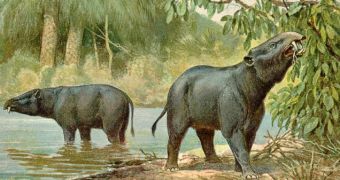Today we associate elephants with forests and savannas. But a new research published in the journal Proceedings of the National Academy of Sciences shows that an elephant ancestor called Moeritherium made its home in rivers and swamps.
In fact, the closest relatives of the elephants are the sea cows (manatees and dugongs), but no direct ancestor of the elephants has been connected to aquatic life until now.
"I think it's the first real evidence that there is a semi-aquatic lineage to the elephants. It's something that people have expected but not been able to actually show," said Alexander Liu, a graduate student in paleobiology at Oxford University.
Moeritherium lived over 37 Ma ago, during the Eocene epoch, in Egypt (which was in those times covered by a rainforest). It had a large body, small eyes located on the top of its head and a short trunk and tusks, resembling somehow a bulky tapir, weighing 500 to 700 pounds (225 to 350 kg). The animal is not new for science, being first discovered in 1901.
The research team investigated the chemical marks in the teeth enamel of Moeritherium, to see what the animal fed on.
"We found that its diet was very similar to that of fully aquatic animals. But we know they can't have been fully aquatic, because the bones we do have show that it must have walked around and put weight on its feet," Liu told LiveScience.
It appears that Moeritherium resembled hippopotamuses in lifestyle, rather than sea cows. The short trunk of Moeritherium evolved later in the elephant's trunk, and many researchers believe the organ appeared as an adaptation for water life.
Humans can only use one-foot-long snorkel tubes, because for deeper snorkels the mismatch between air pressure inside lungs and the increasing outside pressure can make blood vessels swell and rupture.
But elephant lungs are different: instead of having a pleural space between lungs and the chest case as humans and most mammals do, elephants have dense sheets of fibrous tissue, allowing their lungs to withstand pressures that would cause human lungs to collapse. This is a sign that elephant ancestors were aquatic creatures. Initially, the elephant's trunk may have evolved as a snorkel, which also proved useful for gathering food. As animals born with long trunks had an advantage, they thrived.

 14 DAY TRIAL //
14 DAY TRIAL //